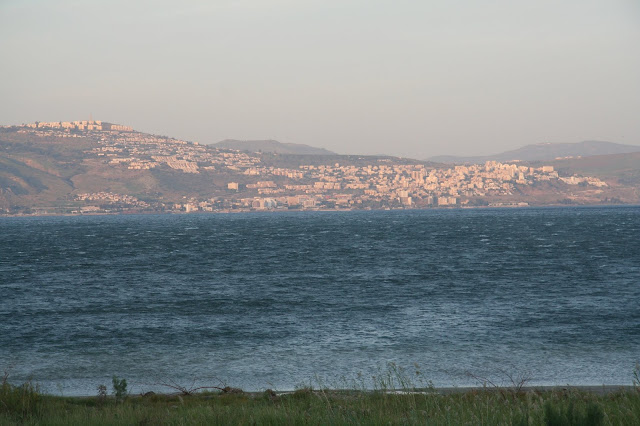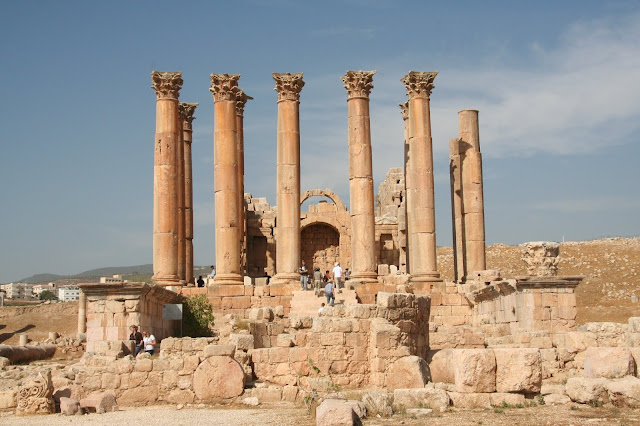Mark 4:
37 And there arose a great storm of wind, and the waves beat into the ship, so that it was now full.
38 And
he was in the hinder part of the ship, asleep on a pillow: and they
awake him, and say unto him, Master, carest thou not that we perish?
39 And he arose, and rebuked the wind, and said unto the sea, Peace, be still. And the wind ceased, and there was a great calm.

The Sea of Galilee (also called Lake Kinneret--Hebrew for harp because of its harp shape, or Sea of Tiberius after its main city) is usually pretty calm, but there are patterns to its storms. Rain storms come in the winter while the summer is hot and dry. The most consistent wind patterns are afternoon sea breezes that appear when warm air rises from the sun-warmed land which then allows cooler air to flow in from off of the Mediterranean Sea--thirty miles to the west. These westerly breezes are usually quite pleasant. Some days they are strong enough to make waves on the Sea of Galilee to the point that it is almost worth trying to body surf. The other type of winds come mostly during the winter and are out of the east. Both of these winds can gain in intensity as they descend down the steep slopes surrounding the Sea of Galilee basin (nearly 700 feet below sea level making it the lowest fresh water lake on earth). The above photos were taken in January 2010 during an easterly wind storm. I was standing on the east bank of the lake and the winds were blowing the waves away from shore eventually creating white caps on the waves further out. Waves like this could certainly get big enough to start to fill up a small fishing boat full of grown men.
Here's a video (not mine) of a similar storm: https://www.youtube.com/watch?v=GloffUv0xKk







Peace be still
By sunset on most days the land-sea breezes have stopped (the sea breezes and setting sun have cooled the land to the point that the warm air is no longer rapidly rising) and the sea is calm.
Mark 5
1 And they came over unto the other side of the sea, into the country of the Gadarenes.
2 And when he was come out of the ship, immediately there met him out of the tombs a man with an unclean spirit,
3 Who had his dwelling among the tombs; and no man could bind him, no, not with chains:
6 But when he saw Jesus afar off, he ran and worshipped him,
7 And cried with a loud voice, and said, What have I to do with thee, Jesus, thou Son of the most high God? I adjure thee by God, that thou torment me not.
8 For he said unto him, Come out of the man, thou unclean spirit.
11 Now there was there nigh unto the mountains a great herd of swine feeding.
12 And all the devils besought him, saying, Send us into the swine, that we may enter into them.
13 And
forthwith Jesus gave them leave. And the unclean spirits went out, and
entered into the swine: and the herd ran violently down a steep place
into the sea, (they were about two thousand;) and were choked in the sea.
source: https://earthobservatory.nasa.gov/images/40147/lake-tiberias-sea-of-galilee-northern-israel
Gadarene is the region rising form the eastern shore of the Sea of Galilee. Most of the recorded ministry of Jesus took place on the northern and northwest areas around the lake.
From atop the eastern hills (region of Gadarene, modern day Golan Heights) looking down on the traditional site of the swine episode.
The Byzantine black basalt rock church at Kursi was build to commemorate the site of exorcism and the plunging.
2010
1982--with BYU student on top of church arch.
The steep hills in the distance is where the swine could have plunged into the sea. There are numerous sites all along this eastern shore where the plunge could have taken place.

The Byzantine black basalt rock church at Kursi was build to commemorate the site of exorcism and the plunging.
1982--with BYU student on top of church arch.
The steep hills in the distance is where the swine could have plunged into the sea. There are numerous sites all along this eastern shore where the plunge could have taken place.

Mark 5
18 And when he was come into the ship, he that had been possessed with the devil prayed him that he might be with him.
19 Howbeit
Jesus suffered him not, but saith unto him, Go home to thy friends, and
tell them how great things the Lord hath done for thee, and hath had compassion on thee.
20 And he departed, and began to publish in Decapolis how great things Jesus had done for him: and all men did marvel.
Jesus commanded the demon free man to go and tell his story in the Decapolis ("ten cities" established by the Greeks and then controlled by Rome). These were mixed cities comprised mainly of Greeks but also Jews, Arabs and Syrians.
Hippus sat right in the middle of the Gadarenes.

The view from ancient Hippus.
Scythopolis (Beit Shean) in the Jordan valley south of the Sea of Galilee. There is no record of Jesus ever visiting this city, but it is likely given that main routes from Nazareth and Capernuam south to Jerusalem would have passed by here. The tel (hill in the distance) was Old Testament Beit Shean. Here the heads of Saul and Jonathan were displayed on the walls of the Canaanite city by the Philistines who defeated Saul. The Greek/Roman/Byzantine city arose down below.
The ruins of Scythopolis (Beit Shean) from atop the tel. Notice the theater in the distance and the long cardo (street) with its many righted columns. Baths and latrines are to the right of the cardo.
Gerasa (Jerash) in northern Jordan has wonderful ruins. Here is the main cardo.
A Roman temple to Artemis at Jerash.
Philadelphia (Amman) with its large theater and other Roman ruins.

The view from ancient Hippus.
Scythopolis (Beit Shean) in the Jordan valley south of the Sea of Galilee. There is no record of Jesus ever visiting this city, but it is likely given that main routes from Nazareth and Capernuam south to Jerusalem would have passed by here. The tel (hill in the distance) was Old Testament Beit Shean. Here the heads of Saul and Jonathan were displayed on the walls of the Canaanite city by the Philistines who defeated Saul. The Greek/Roman/Byzantine city arose down below.
The ruins of Scythopolis (Beit Shean) from atop the tel. Notice the theater in the distance and the long cardo (street) with its many righted columns. Baths and latrines are to the right of the cardo.
Columns that all fell in the same direction testify of several strong earthquakes that helped to destroy the Byzantine city.
A Roman temple to Artemis at Jerash.
Philadelphia (Amman) with its large theater and other Roman ruins.
























No comments:
Post a Comment